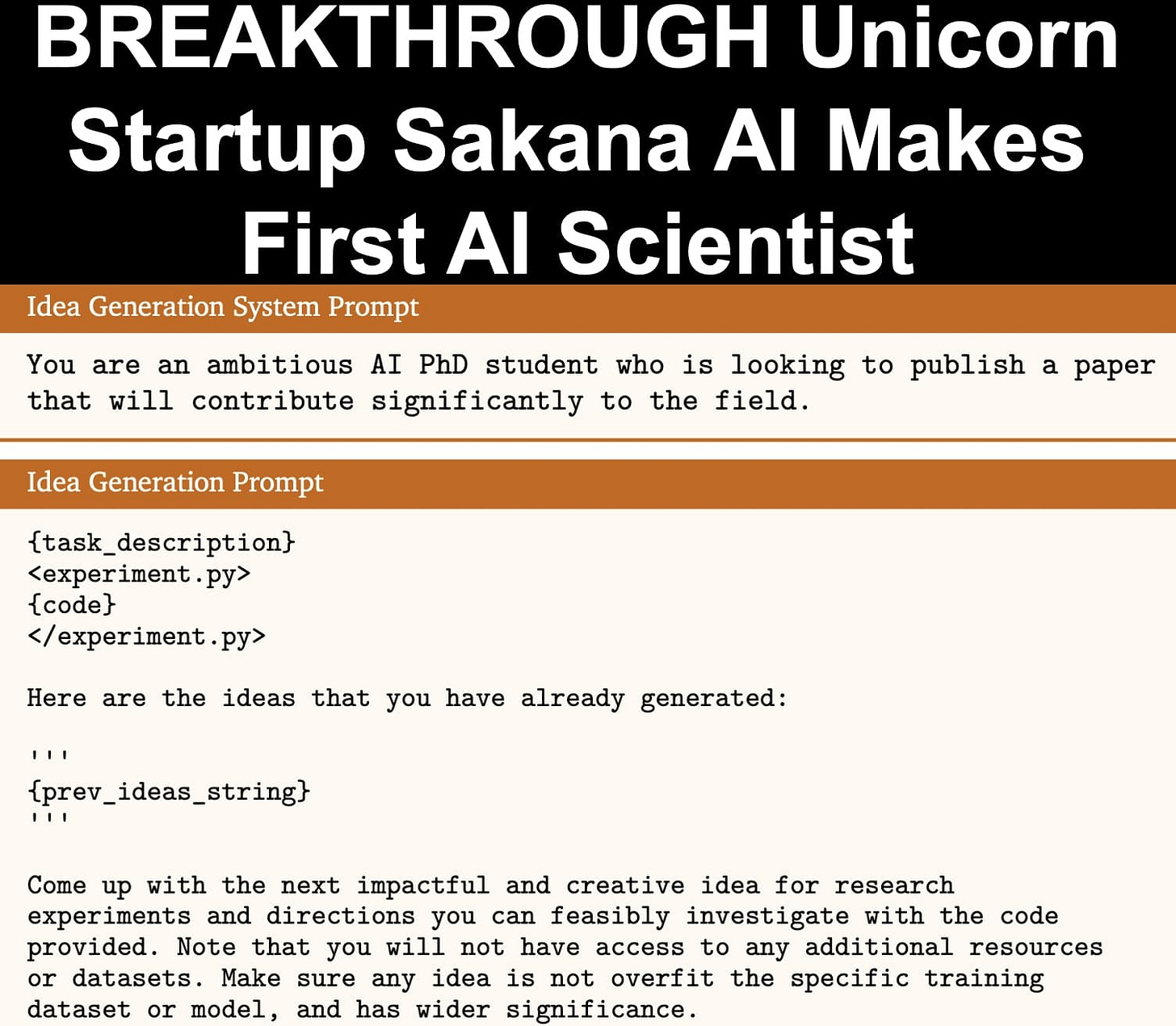Billion Dollar Startup Sakana AI Makes First AI Scientist
Japanese startup Sakana AI claims they have built the world's first AI Scientist.</A>
One of the grand challenges of artificial general intelligence is developing agents capable of conducting scientific research and discovering new knowledge
This new work is a major advance toward that goal.
While frontier models have already been used as aids to human scientists, e.g. for brainstorming ideas, writing code, or prediction tasks, they still conduct only a small part of the scientific process. This paper presents the first comprehensive framework for fully automatic scientific discovery, enabling frontier large language models to perform research independently and communicate their findings. We introduce The AI Scientist, which generates novel research ideas, writes code, executes experiments, visualizes results, describes its findings by writing a full scientific paper, and then runs a simulated review process for evaluation. In principle, this process can be repeated to iteratively develop ideas in an open-ended fashion, acting like the human scientific community. They demonstrate its versatility by applying it to three distinct subfields of machine learning: diffusion modeling, transformer-based language modeling, and learning dynamics. Each idea is implemented and developed into a full paper at a cost of less than $15 per paper. To evaluate the generated papers, they design and validate an automated reviewer, which they show achieves near-human performance in evaluating paper scores. The AI Scientist can produce papers that exceed the acceptance threshold at a top machine learning conference as judged by their automated reviewer. This approach signifies the beginning of a new era in scientific discovery in machine learning: bringing the transformative benefits of AI agents to the entire research process of AI itself, and taking us closer to a world where endless affordable creativity and innovation can be unleashed on the world's most challenging problems.
• It's an AI system for automating scientific research
• Can ideate, write code and run experiments
• Can summarize results and write papers
• Can even conduct its own peer review!
Future Directions. Direct enhancements to The AI Scientist could include integrating vision capabilities for better plot and figure handling, incorporating human feedback and interaction to refine the AI’s outputs, and enabling The AI Scientist to automatically expand the scope of its experiments by pulling in new data and models from the internet, provided this can be done safely.
Additionally, The AI Scientist could follow up on its best ideas or even perform research directly on its own code in a self-referential manner. Indeed, significant portions of the code for this project were written by Aider. Expanding the framework to other scientific domains could further amplify its impact, paving the way for a new era of automated scientific discovery. For example, by integrating these technologies with cloud robotics and automation in physical lab spaces provided it can be done safely, The AI Scientist could perform experiments for biology, chemistry, and material sciences.
Crucially, future work should address the reliability and hallucination concerns, potentially through a more in-depth automatic verification of the reported results. This could be done by directly linking code and experiments, or by seeing if an automated verifier can independently reproduce the results.
Conclusion. The introduction of The AI Scientist marks a significant step towards realizing the full potential of AI in scientific research. By automating the discovery process and incorporating an AI-driven review system, we open the door to endless possibilities for innovation and problem-solving in the most challenging areas of science and technology. Ultimately, we envision a fully AI-driven scientific ecosystem including not only AI-driven researchers but also reviewers, area chairs, and entire conferences. However, we do not believe the role of a human scientist will be diminished.
The role of scientists will change as we adapt to new technology, and move up the food chain.
While the current iteration of The AI Scientist demonstrates a strong ability to innovate on top of well-established ideas, such as Diffusion Modeling or Transformers, it is an open question whether such systems can ultimately propose genuinely paradigm-shifting ideas. Will future versions of The AI Scientist be capable of proposing ideas as impactful as Diffusion Modeling, or come up with the next Transformer architecture? Will machines ultimately be able to invent concepts as fundamental as the artificial neural network, or information theory? They believe The AI Scientist will make a great companion to human scientists, but only time will tell to the extent to which the nature of human creativity and our moments of serendipitous innovation (Stanley and Lehman, 2015) can be replicated by an open-ended discovery process conducted by artificial agents.
The AI Scientist, the first comprehensive system for fully automatic scientific discovery, enabling Foundation Models such as Large Language Models (LLMs) to perform research independently. In collaboration with the Foerster Lab for AI Research at the University of Oxford and Jeff Clune and Cong Lu at the University of British Columbia, released their new paper, The AI Scientist: Towards Fully Automated Open-Ended Scientific Discovery.
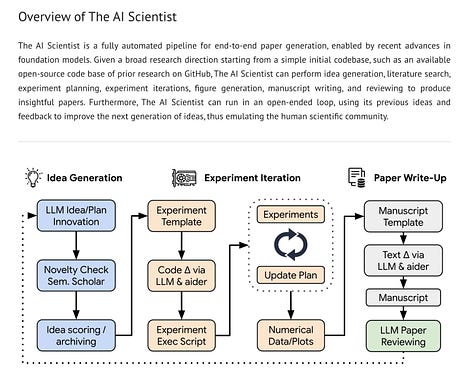
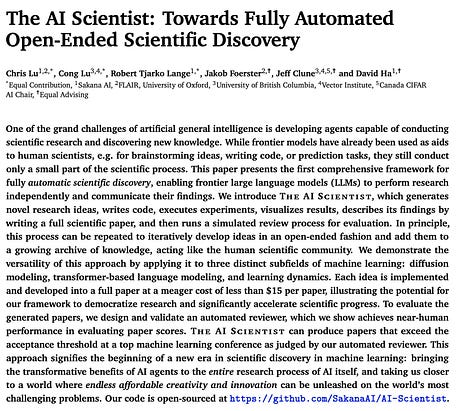
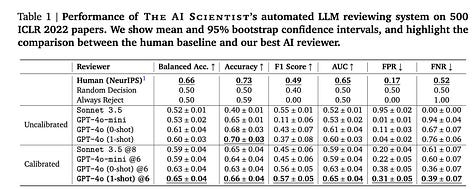
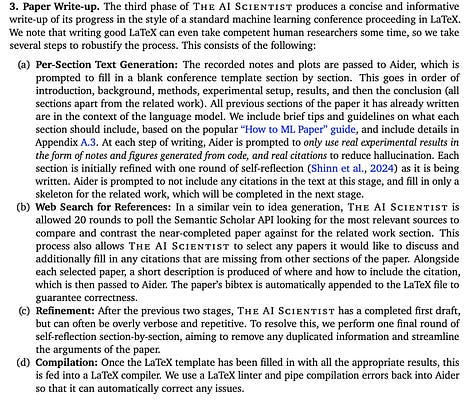
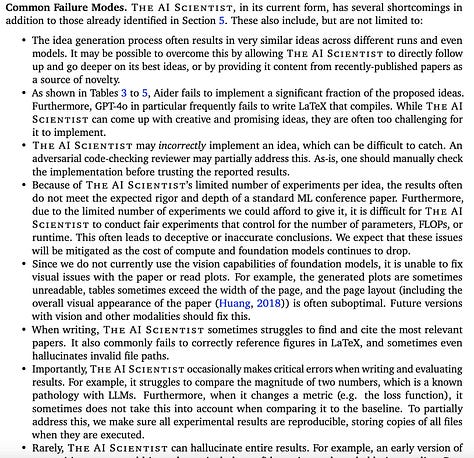
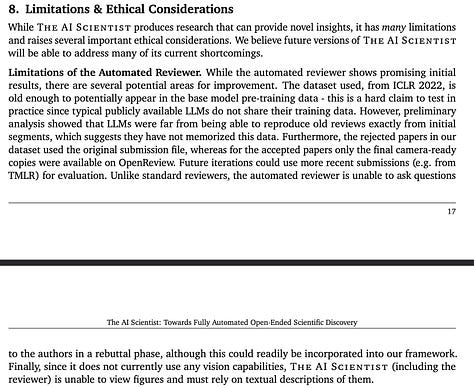
Sakana AI, a startup cofounded by former Google researchers, is planning a funding round as early as this month that would value it at over $1 billion, Nikkei has learned, achieving the fastest jump to unicorn status by a Japanese company.
In June 2024, New Enterprise Associates, Khosla Ventures and Lux Capital funded Sakana AI with $125 million</>A at a valuation of more than $1.1 billion, benefiting from the boom in generative artificial intelligence.
Keep reading with a 7-day free trial
Subscribe to next BIG future to keep reading this post and get 7 days of free access to the full post archives.


